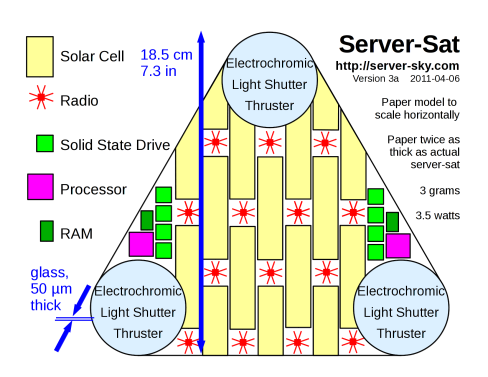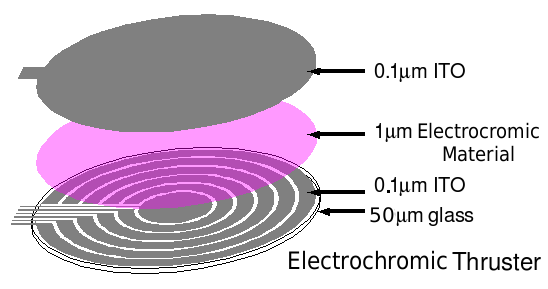|
Size: 7976
Comment:
|
Size: 8036
Comment:
|
| Deletions are marked like this. | Additions are marked like this. |
| Line 9: | Line 9: |
| If the solar cell at end-of-life is 15% efficient, then the solar cell will produce 4 watts. | If the solar cell at end-of-life is 15% efficient, then the solar cell will produce 3.5 watts peak, less during maneuvering, and nothing during eclipse. |
Server Sat Details
Silicon circuits, solar cells, interconnect, are essentially two-dimensional systems. The horizontal dimensions of an integrated circuit die may be measured in millimeters, but all the important action occurs within a few microns of the top surface. Indeed, modern IC die are thinned to increase thermal conductivity and reduce package height. The target thickness for this version 0.3 design is 50 microns, but much thinner silicon wafers are used in current production, often loosely bonded to a thicker "handle" wafer for ease of processing. The server-sat will likely be built and tested with a thick handle wafer attached, but the handle wafer will be removed when the server-sat is attached to the deployment stack.
|
Server satellites are thinned glass sheet covered with very thin Indium Phosphide solar cells and combined with thinned integrated circuit chips, radios with antennas, and three disks of electrochromic material that act as electrically switched mirrors/windows. The glass disk is thinned to reduce weight, and the chips are thinned to match. Reduced weight reduces launch cost and results in a more effective solar sail. The current thickness target is 50 microns, though production glass is often thinned to as little as 30 microns for some applications. 50 micron thick glass is very flexible, and can be rolled to diameters less than a centimeter without breaking. It is not unreasonable to assume that future server-sats can be as thin as 1 to 5 microns, weighing less than a gram. |
If the solar cell at end-of-life is 15% efficient, then the solar cell will produce 3.5 watts peak, less during maneuvering, and nothing during eclipse.
Electronics: A server-sat used for database and web service may need as much as a terabit or more of flash memory (note - databases will be distributed over many server-sats). That will be about 4 by 4 centimeters of silicon area. Computational server-sats will probably need less. While some high-performance processors and chipsets use hundreds of watts, Giga-instruction-per-second level machines can get by with far less. Here is a complete 4 watt system (including IO and power conversion losses) with 990 bogomips performance. Optimized server-sats should be able to do far better.
Because the server-sat is extremely thin, some common electronic components cannot be used: electrolytic capacitors, cored inductors, etc. Bypass capacitors can be made thin, but it is better to keep peak impulse currents low. Some components such as crystal frequency standards may be replaced by surface acoustic wave (SAW) devices. However, other devices such as radios can be operated at low voltages and low impedances, and if some devices need higher voltages at trickles of current they can be powered with capacitive charge pumps. At microwave frequencies, resonators can also be made with striplines and other components. The potential of solid state integrated phased array lasers needs to be investigated for communications, small debris location and control, power transmission and active optical propulsion.
The server-sat will use a small array of radios (many more than the 14 shown) to communicate with neighbors in the array, with other arrays, and with the ground. Besides communication, server-sats will measure radio propagation time to neighbors to accurately compute spacing and orientation, with additional location information provided by other arrays, ground stations, and possibly GPS. Multiple bands will be used, with frequencies that can penetrate atmosphere and clouds used for the downlinks, and other atmosphere-opaque bands used for server-sat to server-sat communication. The server-sats will not have dishes, but will act together as a phased array antenna. Given the wide array spacing, there will be many spurious lobes, but it will still be possible to compute solutions allowing separate beams to many ground stations, far more than a traditional dish-and-transponder comsat. While each server-sat may only dedicate one or two watts to the ground transmitters, the sum of thousands of transmitters will allow quite a lot of power for each beam. With the server-sat in a 4 hour orbit, it will be 7 times closer than a geosynchronous comsat, so there will be a 50x advantage in beam power and ground spot area. Round trip ping time will be 70 milliseconds, less than U.S. transcontinental ping time through optical fiber.
Optical thrusters are a sandwich of patterned, transparent indium tin oxide conductors around a solid state electrochromic material. The conductors are separately controlled strips to permit partial functionality in spite of top to bottom shorts. For more about electrochromic thrusters, see electrochromic materials |
|
Three optical thrusters are shown, which perform pitch and yaw control for the server-sat. Normally, the server-sat is pointed straight at the sun, and the thrusters are electrically stimulated into transparency. If one or two of the disks are unstimulated, they turn reflective, and produce about half a nanoNewton of thrust. This is enough to slowly rotate the disk. If all the thrusters are stimulated, this increases centerline thrust. Again, the thrust difference is not much, but it is enough to keep an array of server-sats on station relative to each other.
There is no direct way to control roll. However, the server-sat can be rolled by combinations of pitch and yaw.
In orbit, the stresses are very small; the disk is relatively rigid by comparison. Maneuvers such as rotation and acceleration will take hours to days; microgee forces are involved. The main stresses on the disk will be from thermal contraction. When exposed to sunlight, the disk will be at 300K; as it passes into earth shadow, it will quickly cool to 150K or less, heated only by the infrared radiation from the night side of the earth. The system is mostly silicon, with some glass and metal. Interconnect metal layers should be designed with strain relief, and the whole metal and insulator stack should have about the same average thermal coefficient as the silicon.
Server-sats are designed to have uniform thickness, so they can be stacked in cylinders for launch. Some kind of very thin separator will be needed, or the server-sats may stick together with vacuum welding or vander Waals forces. If a server-sat plus separators is 60 microns thick, then a stack of 20,000 3 gram server-sats will be 1.1 meters (43 inches) tall and weigh 60 kilograms (130 pounds).
A typical modern geosynchronous communication satellite such as HotBird 9 weighs 4880 kilograms (10,800 pounds) and has a 14kW array, launched by an Ariane 5 ECA, which can put 10,500 kg of satellite and apogee kick motor into a geosynchronous transfer orbit. The planned m288 server-sat orbit is lower; a larger payload is possible. 4200 kilograms is 1,400,000 server-sats and 5.6 megawatts of electricity. Thus, a server-sat array can produce more than 400 times the power (and communication capacity) of typical comsats.
Note: This is version 0.3 of the serversat. Earlier versions were thicker and wider, and made from silicon rather than silicon-matched glass.


